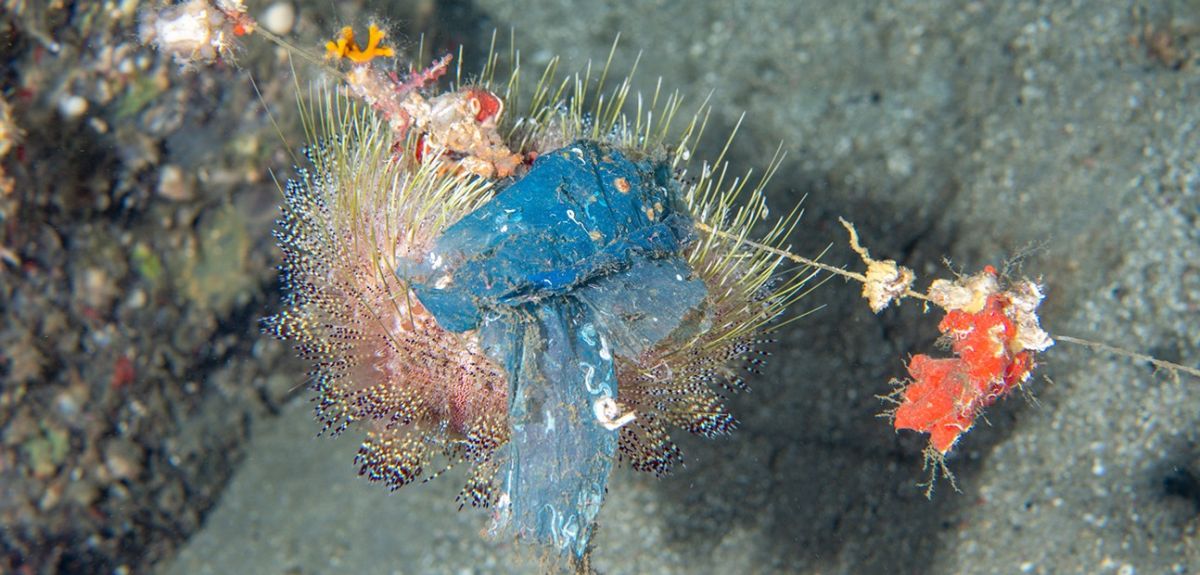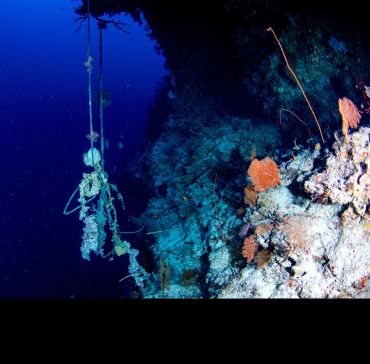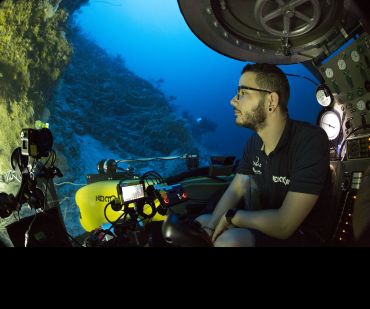
New study finds plastic pollution to be almost ubiquitous across coral reefs, mostly from fishing activities
In the most comprehensive survey to date, researchers have revealed the scale of plastic pollution on coral reefs, even at great depths. These results, however, suggest promising strategies to better protect these biodiversity hotspots. The study has been published today in Nature.
 Fishing equipment entangled on a coral reef at 100m depth. Credit: Luiz Rocha © California Academy of Sciences.
Fishing equipment entangled on a coral reef at 100m depth. Credit: Luiz Rocha © California Academy of Sciences. For the new study, led by the California Academy of Sciences, University of São Paulo, University of Oxford, University of Exeter, and other collaborators, the researchers carried out more than 1,200 visual surveys across 84 reef ecosystems located in 14 countries. These included both shallow (<30m) and deeper (mesophotic or ‘twilight’ zone at 30 – 150 m depth) reefs across the Indian, Pacific, and Atlantic Oceans, covering approximately 68,000 m² of coral reef area. The researchers used a combination of manually counting plastic debris found alongside 20m long transects, and counting debris captured in footage from diver-operated video systems, remotely operated vehicles, and manned submersibles.
Human-derived debris was present in nearly all locations (77 reefs out of 84), including some of the planet’s most remote and pristine coral reefs, such as those adjacent to uninhabited islands in the central Pacific. Of the total debris, 88% was macroplastics larger than five centimetres. Although some of this was consumer debris, such as water bottles and food wrappers (often the main source of plastic pollution in other ecosystems), nearly three-quarters of all plastic items documented on the surveyed reefs were related to fishing, including ropes, nets, and fishing lines.
According to the study, coral reefs appear to be more contaminated by plastics and human-derived debris in general than other marine ecosystems that have been evaluated, but are much less polluted than shoreline ecosystems such as beaches and wetlands. However, contrary to studies of near-shore environments, the researchers found that the amount of plastic increased with depth—peaking in the mesophotic zone—and was mostly derived from fishing activities.
The results of our global study shine a light on one of the many threats that deep reefs face today. Because these ecosystems are ecologically and biologically unique, much like their shallow-water cousins, they need to be conserved and explicitly considered in management plans.
Dr Paris Stefanoudis, University of Oxford
Contributing author and marine biologist Dr Paris Stefanoudis (based at the Department of Biology at the time of the study, now Oxford University Museum of Natural History) said: ‘It was initially surprising to find that the amount of plastic debris increased with depth, as we would expect deeper reefs to be further from sources of pollution. Potential causes of this include the action of waves near the surface dislodging debris and carrying it to greater depths; shallow corals with higher growth rates obscuring items from surveyors; and recreational divers removing debris from more accessible shallow reefs.’
The lowest densities of pollution—around 580 items per square kilometre—were observed in locations such as the Marshall Islands. Comoros, an island chain off the southeast coast of Africa, had the highest density of pollution with nearly 84,500 items per square kilometre: the equivalent of around 520 pieces of debris on a single football field.
Troublingly, because deep reefs are more difficult to study, they are rarely included in conservation discussions and actions, despite harbouring unique biodiversity not found on shallow reefs. To uncover the drivers of coral reef pollution, and identify potential solutions, the researchers assessed how the abundance of human-derived debris correlated with various geographic and socioeconomic factors. In general, pollution on reefs increased with proximity to densely populated cities, local markets, and, counterintuitively, marine protected areas.
 Dr Paris Stefanoudis examining deep reefs in a submersible during an expedition to the Seychelles in 2019. Image credit: Nekton.
Dr Paris Stefanoudis examining deep reefs in a submersible during an expedition to the Seychelles in 2019. Image credit: Nekton.Despite these sobering findings, the new insights from the study suggest solutions that could be effective in reducing the amount of plastic pollution reaching deeper reefs. These include expanding the depth of marine protected areas to include mesophotic reefs; updating international agreements to include fishing equipment; and developing low-cost biodegradable alternatives to fishing gear that will not adversely impact the well-being of coastal communities that rely on sustainable fishing for their livelihoods.
‘Coral reefs are losing the capacity to sustain their fundamental ecosystem functions, with plastic pollution adding to the threats from climate change and overfishing. As the world moves towards a global treaty to tackle plastic pollution, understanding its distribution and drivers provides key information to help design strategies needed to address this ubiquitous threat’ concluded Dr Stefanoudis.
The study ‘Plastic pollution on the world’s coral reefs’ has been published in Nature.
 New Year Honours 2026
New Year Honours 2026
 New study estimates NHS England spends 3% of its primary and secondary care budget on the health impacts of temperature
New study estimates NHS England spends 3% of its primary and secondary care budget on the health impacts of temperature
 International collaboration launches largest-ever therapeutics trial for patients hospitalised with dengue
International collaboration launches largest-ever therapeutics trial for patients hospitalised with dengue
 Oxford-built multi-agent assistant for cancer care to be piloted in collaboration with Microsoft
Oxford-built multi-agent assistant for cancer care to be piloted in collaboration with Microsoft